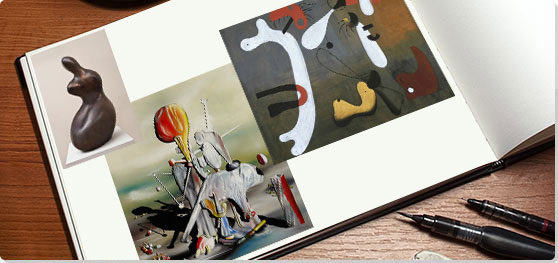Summary of Biomorphism
Amidst a societal hangover from World War I, many European artists were going inward to mine what lies beneath. Many took part in the burgeoning interest in psychology and the physical sciences, finding inspiration in both the invisible signs and symbols that bubbled up from the subconscious and the visible internal cellular structures and life forms that make up the body. With roots deeply connected to Dada and Surrealism, an intuitive mode of expression coined "Biomorphism" emerged, in which an artwork's elements became modeled on naturally occurring patterns, biological forms, and shapes. This fluid way of creating art from emotion and its resulting curvilinear aesthetic infiltrated all parts of society from painting and sculpture to decorative arts and interior design.
Uncapitalized, the term "biomorphic" was used to describe earlier treatments in art history, such as Rococo's common decorative motif resembling shells and acanthus leafs or Art Nouveau's serpentine arabesques, as well as in Islamic art's motifs evoking plant forms. It is also applied to organic-like forms used in various subsequent art movements.
Key Ideas & Accomplishments
- Biomorphism lent itself perfectly to the Surrealist impetus to portray the internal unconscious through automatic, stream-of-consciousness art. Even with sculpture, the practice of Direct Carving and using the material's grain, texture, and density to energetically shape the artwork, carried the mark of automatism. By allowing the art medium and material to inform an intuitive flow of expression, the artist brought forth a connection between the viewer and his or her own inner spirit - an artistic bridge between the human subconscious and reality.
- Many biomorphic forms were seen as abstracted derivations of reality, both slightly recognizable and non-identifiable simultaneously. A common motif emphasizing this relationship between familiarity and ambiguity was in the visual correspondence between the human body and the natural landscape.
- To create biomorphic images and textures, artists employed a slew of innovative painting techniques including decalcomania, where a piece of glass or paper was placed over a painted surface then removed; grattage in which an object was placed beneath paper and then painted over; and frottage, laying paper over an object and then rubbing with charcoal to create an imprint.
- Many Biomorphic artists believed that the intuitive process of organic abstraction in art was an essential vehicle, via which one could arrive at the great elemental truths of existence, fortify their own spiritual aspirations, and reveal visions and messages about the future.
Overview of Biomorphism
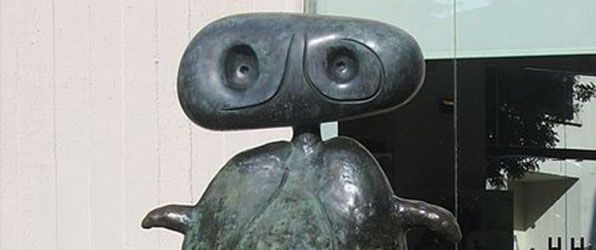
The Surrealist Joan Miró said “I intend to destroy, destroy everything that exists in painting. I have utter contempt for painting.” By the 1960s, Miró had indeed transcended the canvas and moved into sculpture, producing strange, comical characters that he called “personages” as he sought through Biomorphism to reflect humanity through his three-dimensional, phantasmagoric worlds.
Artworks and Artists of Biomorphism
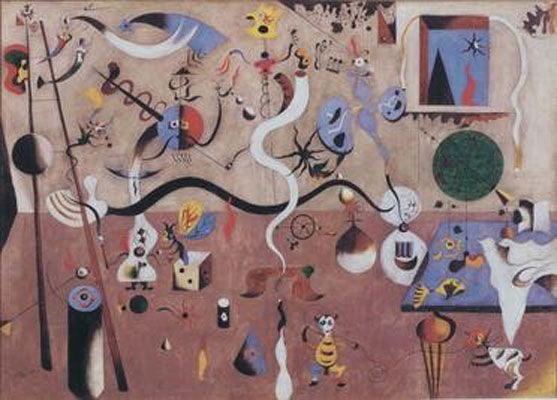
Harlequin's Carnival
Every area of this festive pictorial space is inhabited by lively and quixotic biomorphs, some of which are identifiable while simultaneously being non-representational like the small "cat" in the lower right, standing on its hind legs and leaning forward with outstretched "arms." The juxtaposition between true resemblances evoked and those improbably reconfigured creates a sense of an imagined world, itself evoked by the green globe at center right, populated by dream creatures. The title's harlequin stands at central left, identifiable as the stock character in the Italian commedia dell'arte by the black and white checks on his "torso." His body is shaped like a distorted guitar, as, wearing an admiral's hat and sporting a pipe and a long swirling mustache, his whimsical appearance is belied by his sadness. His red and blue face stares out at the viewer, while a hole in his stomach perhaps reflects the artist's own hunger, as he described coming home after a day of no food and creating the painting in a kind of automatic trance.
Pioneering Miró's biomorphic approach, the work was his first truly Surrealist painting. The biomorphic forms invited symbolic meaning, as Miró explained the green sphere represented his obsession with "conquering the world," or that the black triangle symbolized the Eiffel Tower, while the ladder with its ear and eye represented both evasion and elevation. Yet, the forms, merging and melding like teaming protozoa seen by a microscope, overturn the hierarchies of the conscious world, including those of art. The viewer is drawn into the wonderment of the floating hand, the strange squiggly creatures, and the shooting stars. As the artist said, "I'm only interested in anonymous art, the kind that springs from the collective unconscious."
The harlequin, a character known as foolish and always unhappy in love, became a popular stand-in for artists as early as the Rococo period. It was seen in Antoine Watteau's Harlequin, Emperor on the Moon (1707), and was often employed by Picasso as seen in his Harlequin with Glass (1905).
Oil on canvas - Albright-Knox Art Gallery, Buffalo, New York
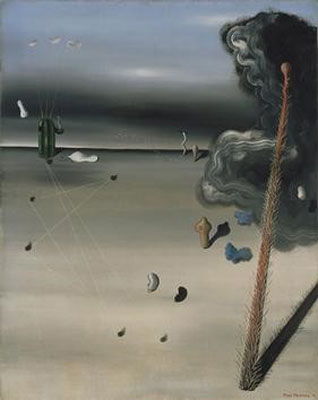
Mama, Papa is Wounded!
In a vast landscape, a kind of eerie light illuminates a hairy stalk extending upward on the right toward a dark clotted form. On the upper left, along a dark horizon, a cactus-like form is caught in a kind of cat's cradle of cobwebs that extend into the foreground. Small biomorphic shapes, casting strong shadows, stand on the pallid sand. A mysteriously ominous feeling is created as associations are evoked while escaping identification.
To create the work, the artist painted the background first, before adding his unique creatures, that resemble microscopic animals, bone-like shapes, vegetable forms, and melted stone. Andre Breton dubbed them "subject-objects" as they seem both objects of contemplation but subjects with agency.
As art historian James Thrall Soby wrote, "The picture illustrates with extraordinary acuteness a relative constant of Tanguy's technique: the dual manipulation of perspective, from far to near and from high to low.. perhaps no other modern painter has so insistently dramatized an opposition between these two dimensions. The fascination.. stems in part from its ambiguous placing of forms within vertical space, as if.. gravity had lost its hold and released a chimerical medley above the placid earth."
This work was exhibited in Tanguy's first solo exhibition at the Galerie Surréaliste, where Breton wrote in the catalogue that Tanguy "invited us today to meet him in a place which he truly discovered...There are no landscapes. There is not even a horizon. There is only, from the physical point of view, our immense suspicion which surrounds everything." Breton also described the origins of the title; "I remember spending a whole afternoon with him...leafing through books on psychiatry in the search for statements of patients which could be used as titles for paintings. The picture.. Mama, Papa is Wounded! is one of them." The title only heightens the ambiguity of what art historian Nathalia Brodskaïa described as "The emptiness of the endless plain, the threatening cloud of black smoke moving overhead, the solitary, prickly plant and the forsaken, helpless creature-objects inspire a sensation of acute anxiety."
Tanguy became well known due to such works, and he influenced his contemporaries including Arp, Salvador Dali, and Isamu Noguchi, as well as later Surrealists including Roberto Matta, Esteban Francés, and Wolfgang Paalen. His development of automatic painting also influenced Mark Rothko and Jackson Pollock. Carl Jung, whose psychological theories informed Surrealism, later used one of Tanguy's works to illustrate his concept of the collective unconscious.
Oil on canvas - The Museum of Modern Art, New York
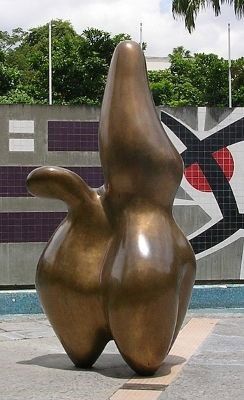
Cloud Shepherd
The highly polished surface of this bronze work lends an illusion of softness, as if the surface had been eroded by wind or rain. The voluptuous lower forms suggest limbs as they uplift into curvaceous and buoyant shapes. The figure is whimsically anthropomorphic.
Arp is well known for Cloud Shepherd, his first large scale public work which exists in several versions throughout the world, and which also plays with the viewer's perception, as it both evokes clouds and reflects clouds and their shadows on the burnished mirror of its surface. By the 1950s Arp had become famous for his biomorphic sculptures which he pioneered 20 years earlier as he created plaster models and then sanded them in a kind of automatic state, saying, "I work until enough of my life has flowed into its body." He intended to create a correspondence between artistic creativity and nature's creative forces, as he saw both as flowing from an intuitive source.
Originally he made small sculptures and placed them in the woods, near his home in Meudon, France, so they might be randomly discovered by passersby. As art curator Cathy Craft said, "He wanted to give his works more freedom for interpretations, to let in other emotions like humor and not control the viewer's response.. viewers could actually become participants in the composition of the sculpture by moving these objects around. And that kind of freedom in 1930 was very unusual."
Arp's sculpture influenced Barbara Hepworth, Henry Moore, and later artists, including Ken Price and Tony Craig. As art critic Michael Kimmelman wrote, "dozens of painters who nowadays explore biomorphic abstraction depend, more or less knowingly, on Arp. So do many of the Conceptualists, who trace their roots to Dada. And so do many of the abstract painters whose textured, layered surfaces find precedents in some of the painted wood reliefs.. Arp was also among the first to promote collective, anonymous art."
Bronze - Collection of Central University of Venezuela, Caracas
Mother and Child
This small, horizontal abstract sculpture, made of two pieces of Cumberland alabaster, takes on an undulating biomorphic shape that suggests a reclining mother with child upon her knees. The stone's warm colors, veined with brown, black, and grey, create a unity between the independent figures and suggests intimate feeling, while the form also denotes a natural landscape, conveying harmony with nature.
As artist and writer Adrian Stokes wrote, "So poignant are these shapes of stone, that in spite of the degree in which a more representational aim and treatment have been avoided, no one could mistake the underlying subject of the group.. Miss Hepworth's stone is a mother, her huge pebble its child." Hepworth explored the mother and child motif as early as 1927, in work that both reflected her own experience as a mother, and became a dominant subject of her art. In 1934, when this work was created, she had just had triplets, and she described, how in "a turbulent period 1933-34," the work "mattered a lot emotionally and sculpturally."
Hepworth was radically innovative for employing negative space within her forms, which in this piece is seen as a hole in the center. Art historian Matthew Gale wrote, "for Hepworth the piercing of Mother and Child went beyond a formal device. It carried a conceptual value, with the suggestion that the child had come from - and outgrown - the vacant space in the centre of the mother's body." Hepworth was also the first British sculptor to employ two pieces, rather than what Gale and Chris Stephens called "a single integral sculptural mass." Though Arp's multi-pieced sculptures influenced her work, rather than inviting the viewer to hold and reconfigure the sculpture as he did, she primarily used the two pieces to establish identity and duality, while positing it so the two seemed conceptually and necessarily one.
This work was informed by Brancusi's 1906 practice of Direct Carving, rather than using models, where the qualities of this Cumberland alabaster played a dominant role in shaping and polishing the work. Both Hepworth and Henry Moore used the stone from 1930-34, as the sculptor John Skeaping, who was Hepworth's ex-husband, had given them the raw stone, ploughed up by a local farmer.
Cumberland alabaster on marble base - Collection of the Tate, United Kingdom
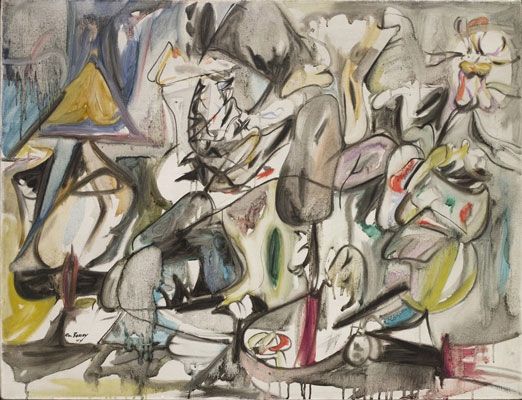
The Leaf of the Artichoke Is an Owl
This painting, created by automatism, is a dynamic plethora of curving lines, seeping transparencies, and melting forms, recognizable vaguely and momentarily as a hint of table, the handle and red stained blade of a knife, and a lamp base and triangular shade. Yet, the overall effect is of a densely overgrown forest floor, swarming with mushroom-like forms, bits of plants, and decaying matter. Though this work depicts an interior scene, as art critic Martin Ries wrote, "it is non-spatial and mental. We, the observer, are.. in the midst of a pantheism of fungi, matter and verdant shags of grassland."
Gorky innovatively poured thin paint onto the canvas, utilizing the liquidity of the pigment to follow his automatic gestures. The work originated from a dinner with André Breton in New York, at which the leader of the Surrealists compared an artichoke leaf to an owl, thus giving the work its title. Breton said Gorky was "the first painter to whom the secret has been completely revealed," and dubbed the artist's biomorphic images "hybrids," which he said were "resultants provoked in an observer contemplating a natural spectacle and a flux of childhood and other memories."
In the early 1940s Gorky was influenced by both Kandinsky and Miró, and began a series of drawings and paintings that focused on landscape, as he visited his wife's family farm in Virginia. He stated, "I got them [the abstract forms] from getting down close to the earth." He described looking with intense concentration into the grass, "I could hear it and smell it. Like a little world down there."
Oil on canvas - The Museum of Modern Art, New York
Kouros
This nine-foot-tall sculpture pays homage to the kouros, or "young man" statues, often nude, that were popular in the age of Classical Greece. Its assemblage of biomorphic parts resembles a fragmented body's thighbones or femurs. The grain and color of the pink marble enhance the effect, giving the extended verticals a weathered look, as if subjected to the effects of erosion and of time. The classical ideal of human and aesthetic beauty is here transformed into a work that conveys the feeling of an ancient ruin, excavated out of sandy earth, and composed like a sign or marker, testifying to the past.
Notching was used to connect the individual pieces, as Noguchi said, "You have to consider the weight of the material, the forces that conspire to hold up the figure - engineering problems, essentially. Everything I do has an element of engineering in it - particularly since I dislike gluing parts together or taking advantage of something that is not inherent in the material . . . there are no adhesives of any kind - only the stones holding themselves together." Between 1945-48, he made 15 of these interlocking works and saw them as reflecting "the encroaching void" felt after World War II.
Born and raised in Japan, Noguchi moved for his studies to the United States in 1918 and later to Paris in 1927 where he met Brâncuși and spent seven months working as his studio assistant. Working in stone was a new medium for the young artist, and his work was profoundly impacted by both Brâncuși's practice of Direct Carving and use of biomorphic shapes, though Noguchi felt his work's organic quality was primarily sourced from traditional Japanese art.
Marble - The Metropolitan Museum of Art, New York
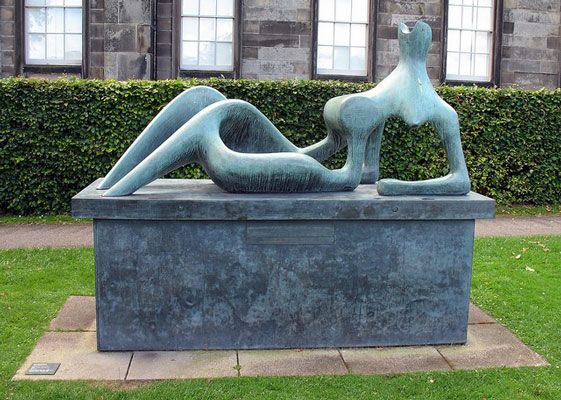
Reclining Figure
Because of its flowing contours and open form, this biomorphic shape both resembles a reclining woman while evoking hills, valleys, and eroded rock formations. Although the viewer recognizes the allusions to body parts in the human head, shoulders, and breasts, the open space where her torso would be interrupts the identification and creates a sense of fluid ambiguity. As Moore wrote in 1937, "there are universal natural shapes to which everybody is subconsciously conditioned and to which they can respond if their conscious control does not shut them off."
The Chacmool, a pre-Columbian sculpture of a reclining figure, heavily influenced Moore. In 1924, he began creating his own figures that were similarly angular and bulky, though, unlike the Chacmool, always feminine. In the 1930s, influenced by Surrealism and also by his association with Barbara Hepworth, the artist turned to biomorphic treatments made by Direct Carving. Feeling, as he said, that the material itself had "an intense life of its own," he described his process as a sculptor who "gets the solid shape, as it were, inside his head.. he identifies himself with its center of gravity."
When the 1948 Venice Biennale awarded the prize for sculpture to Moore, it cemented his standing as Britain's greatest living sculptor. This work was commissioned by the Arts Council for the Festival of Britain in 1951. To create the work, Moore developed a different working method, first creating plaster maquettes, then a small bronze which became the model for the work. He felt this sculpture was one of his most important works, describing it as, "my first sculpture where the space and the form are completely dependent on and inseparable from each other. I had reached the stage where I wanted my sculpture to be truly three-dimensional. In my earliest use of holes in sculpture, the holes were features in themselves. Now the space and form are so naturally fused that they are one."
Bronze - Scottish National Gallery of Modern Art, Edinburgh, Scotland
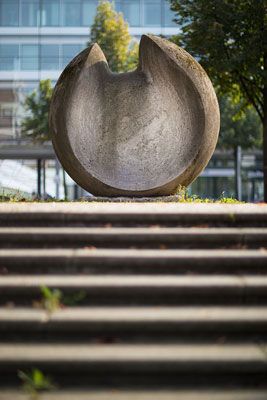
Grosse Kugelform (Large Spherical Form)
From one viewpoint, this large stone sphere suggests the shape of the earth, while, from another viewpoint, deeply hollowed and asymmetrically concave, it suggests a cellular form reminiscent of a red blood cell. As art historian Godehard Janzing wrote, the abstract work creates "a tense formal relationship between convex and concave curvatures," but also powerfully resonated within post-war Germany, a country divided into East and West. The wedge-shaped cut at the top of the sphere evokes both injury and a mouth, and as Janzing wrote, the sculpture, "suggested the possibility of further growth - which could be either a generative or a degenerative movement. These formal characteristics were compared with the fate of the nation, its supposed incompleteness and its struggle for unity."
Hartung, a German artist, first trained as a wood sculptor in Paris and Florence before returning home to Germany. His work in the early 1930s became influenced by Brâncuși and Arp. This work was the first abstract public monument in West Germany. Originally displayed in 1951 at Constructa, a post-war architectural exhibition, it provided an organic contrast to the exhibition's Cubist pavilion. Though the artist resisted assigning meaning to the abstract work, the public and critics saw it as the formal embodiment of a divided Germany. As a result, the work was installed as a public monument in 1959 in the center of Hanover and dedicated to the East German uprising on June 17, 1953. A plaque reading "Unity, justice, and freedom" was installed in the pavement beside it, and the work, as noted by Janzing, marked "a new era of monuments."
Stone - Hanover, Germany
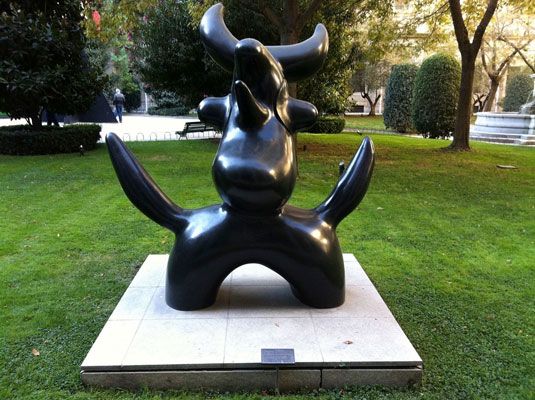
Pájaro lunar (Moonbird)
In this signature work, Miró presents a strange, biomorphic creature with a lunar-shaped face and "horns," which simultaneously evoke the crescent moon and the Spanish tradition of bull fighting. Additionally, the hybrid is part bird, though its two "wings" are upward arcs, devoid of plumage. The work has a kind of totemic effect, its squat horizontal body suggesting a powerful grounding in the earth, while its replicating arcs evoke the heavens. As art historian Carmen Fernández Aparicio wrote, "Miró brought together metaphorical mineral forms and ideas from the natural and cosmic world to create a strange, hybrid character, a sort of monster with a shining, polished surface."
In the 1940s Miró began creating sculptures like this one, molding them by hand, before casting. As Aparicio noted, "one can see the legacy of the nature-based organic forms so closely associated with one section of early surrealist sculpture - .. but with a subject area that was typical of the Catalan painter, referring equally to the Constellations series done during Second World War and to the world of birds, which Miró saw as the connection between the terrestrial and celestial worlds." As the artist said, "The spectacle of the sky overwhelms me. I'm overwhelmed when I see, in an immense sky, the crescent of the moon, or the sun." Casts of the iconic work can be found in museums, institutions, and parks throughout the world.
Bronze - Museo Nacional Centro de Arte Reina Sofía, Madrid
Soft Landscape
Here, two biomorphic shapes seem to bubble out of a molten ground suggesting both landscape and the human body. The use of caramel-colored resin creates a sense of living fluidity, evoking membranes and soft moist surfaces that flux and burgeon, as the shapes take on an ambiguous sexuality. As the artist said, the "body could be considered from a topological point of view, a landscape with mounds and valleys and caves and holes, so it seems rather evident . . . that our body is a figuration that appears in Mother Earth."
In the 1950s Bourgeois began to explore what she called a "softening" in her work, using more curvilinear and bulbous forms, furthered emphasized in her 1960s turn to plastic and resins. Her work explored childhood trauma and the deep psychic recesses of human consciousness. She has said, "Psychoanalysis is my religion."
Bourgeois evolved the legacy of biomorphic Surrealism while innovatively exploring what critic Siri Hustvedt called, "a hallucinatory pre-linguistic space of primal drives" with its "unstable borders, sliding recognitions, aggressive sexual ambiguity, and visions of the body amputated, in pieces, or sprouting extra parts." By utilizing her own traumatic autobiography and personal psychology to guide highly intuitive works, she paved the way for a generation of artists who were turning the personal political, or trying to shed light on how art can process out wounds through the very act of its practice - the Surrealist impetus pushed into a contemporary, conceptual, confessional lexicon. Her work influenced artists like Louise Nevelson and informed the Feminist art movement of the 1970s, influencing Lynda Benglis and Judy Chicago, as well as later artists like Tracey Emin.
Plastic - Cheim & Read, Galerie Karsten Greve and Hauser & Wirth
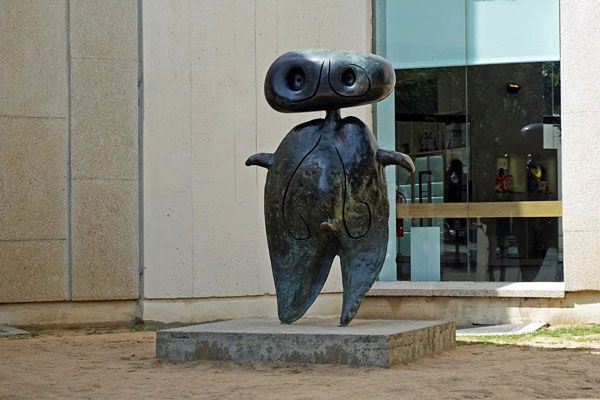
Personage
In this powerful and imaginative work, the human is abstracted to the humanoid, as the large sunken eyes, emphasized by curving incisions in the flattened curvilinear shape of the head, also evoke a figure freshly stepped out from one of Miró's own paintings. The biomorphic treatment allows for surreal associations that work metaphorically: the eyes are owl-like, the wide body on its differently sized "legs" evokes a vegetable shape, while the small handless arms appear as flippers.
By the 1960s, Miro had made a number of these types of "personages." The work related to Carl Jung's concept of the persona, or social mask, that all humans wear, giving us a glimpse into various forms, figures, and feelings the artist connected with his own self, or was inspired by in others. As the artist said, "Mocking my personages. Mocking man, that puppet which cannot be taken seriously," the works are both whimsical and tragic. They allude to the archetypes and characters that are common to us all in the communal buffoonery we call life.
The piece perfectly reflects Miro's own artistic statement, "It is in sculpture that I will create a truly phantasmagoric world of living monsters," by which he meant showing humanity's true reality.
Bronze - Fundació Joan Miró, Barcelona, Spain
Beginnings of Biomorphism
The capitalized term Biomorphism first emerged in 1936 when art historian Alfred H. Barr first used "biomorphic sculpture" for his exhibition Cubism and Abstract Art (1936). Barr, the founding director of New York's Museum of Modern Art, created a famous and influential flow chart that divided the development of abstraction into two currents. The trend that became known as Biomorphism was described as "intuitional.. emotional.. organic or biomorphic.. curvilinear.... in its exaltation of the mystical, the spontaneous and the irrational." It stood in contrast to the "Paul Cézanne - Cubist geometrical tradition" described as "intellectual, structural, geometrical, rectilinear and classical in its austerity and dependence upon logic and calculation." Contrasting the "Cezanne-Cubist" works of Piet Mondrian and Naum Gabo with the Biomorphism of Hans (Jean) Arp and Joan Miró, Barr quipped, "The shape of the square confronts the silhouette of the amoeba."
Wassily Kandinsky and Constantin Brâncuși
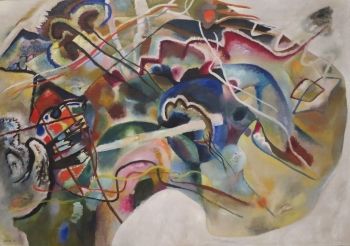
Barr also said that Biomorphism descended from "the art and theories of Gauguin and his circle" and that it "flows through the Fauvism of Matisse to the.. pre-war paintings of Kandinsky." In Munich in 1911, Wassily Kandinsky cofounded the Der Blaue Reiter group alongside artists Franz Marc, August Macke, Gabriele Münter, and others. The group emphasized an Expressionist approach and Kandinsky's influential On the Spiritual in Art: And Painting in Particular (1911) emphasized abstraction as most the effective means to reveal elemental truths, spiritual aspirations, and a vision of the future. His abstract works that led to his being dubbed "the father of abstract painting" were equally pioneering in Biomorphism, as elements in his Painting with White Border (1913) suggest trees, a figure on horseback, a dragon, while, as the artist wrote, the overall shape resembles both, "an upspringing flower," and an "egg-like shape." The piece used organic form and movement to convey what Kandinsky described as "extremely powerful impressions" of his short trip home to Moscow in 1912.
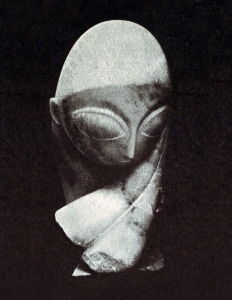
Biomorphism's sculptural treatments also adopted Constantin Brâncuși's practice of Direct Carving, a process that emphasized the interaction with the raw material itself, as the grain, texture, and color shaped the final work. Additionally, his biomorphic shapes as seen in his Portrait of Mademoiselle Pogany (1912), where the head takes on an egg-like shape, also evoked a shell folding in on itself in curvilinear planes resonated with the later Surrealist movement.
Hans Arp
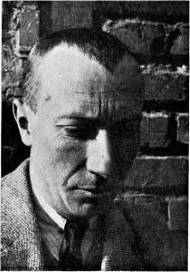
The sculptor, painter, and poet Hans Arp was a leading pioneer in a number of art movements, including Der Moderne Bund, the first artistic organization to promote modern art in Switzerland. As a result, he met Kandinsky in 1912, and a collaborative relationship and correspondence quickly developed between the two men and their companions, the artists Gabriele Münter and Sophie Taeuber. Arp was heavily influenced by Kandinsky's biomorphic works, such as Improvisation with Horses (1911), which he selected for a Der Moderne Bund exhibition.
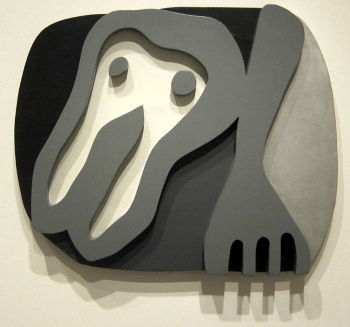
In Paris in 1920 Arp met Brancusi, and, while it did not lead to a long association, Arp would later write a poem in homage to the sculptor's work, describing Brancusi's sculptures as "fables plastiques" (meaning plastic fables), as one form metamorphosed into another. Subsequently, Arp began using biomorphic shapes in collages and wood reliefs, as seen in his Shirt Front and Fork (1922). In it, the curvilinear shape of the fork evokes a human hand, while the shirt front on the left ambiguously suggests the shape of a tooth, the face of a macaque, or a cross section of a green pepper, while simultaneously resisting any identification. The work's Biomorphism, in its provoking of associations, heralded Arp's transition from Dada to Surrealism.
Surrealism
Biomorphism became a major theme in Surrealist art, led by Arp, who was one of the group's founders, in 1924. Along with Joan Miró, and Yves Tanguy, he felt that biomorphic images reflected the connection between the human subconscious and reality more accurately. He often created his works in a state of automatism, the performance of creative actions without pre-calculated thought or composition. In the "The Surrealist Manifesto" (1924), André Breton defined the movement as "psychic automatism in its pure state, by which one proposes to express.. the actual functioning of thought." The concepts of the psychiatrists Sigmund Freud, as expressed in his The Interpretation of Dreams (1899), and Carl Jung's collective unconsciousness, in which humanity shared an unconscious state where myths and archetypes originated, were the scientific and theoretical underpinnings of the movement. The biomorphic approach was distinguished from the hyperrealism that dominated other Surrealist imagery, as exemplified in the works of Rene Magritte and Salvador Dali.
Scientific Developments and Biomorphism
Biomorphism drew not only upon the new science of psychology but the biological and physical sciences. As historian Charlotte Douglas noted, at the beginning of the 20th century, "the image of cells - their internal structure, and their division and multiplication in the process of organic growth - now appeared in the popular press, and for the first time became easily accessible to artists." Kandinsky, as well as other artists, studied Ernst Haeckel's Art Forms in Nature (1904), illustrating biological and botanical forms. The discovery of subatomic particles influenced Wolfgang Paalen, while Yves Tanguy often employed geological images in his paintings. In 1941 the electron microscope became commercially available, and the resultant images, revealing the structures and processes of cellular forms, reached a wide audience and reinvigorated artistic interest.
The World War II Era
World War II splintered the avant-garde art world in Paris, as many artists fled from the German occupation. Miró returned to Spain and Arp to Zurich, while Tanguy, Breton, Max Ernst, Marcel Duchamp, and Salvador Dalí went to New York, where they had a revitalizing influence. Miró's 1941 retrospective at the Museum of Modern Art received a great deal of artistic and critical attention, and Peggy Guggenheim's Art of This Century Gallery, opening in 1942, became an artistic hub, exhibiting both the leading Surrealists and the emerging Abstract Expressionists. Arshile Gorky, Isamu Noguchi, Roberto Matta, and Louise Bourgeois became a kind of second wave of Surrealists working in biomorphic forms. At the same time, the Abstract Expressionists Jackson Pollock, Robert Motherwell, and William Baziotes, along with Gorky, began meeting at Matta's studio to explore automatism, though emphasizing a kind of automatic gestural painting, while developing biomorphic imagery.
Biomorphism: Concepts, Styles, and Trends
Painting
Biomorphic painting often employed automatism to access the artist's unconscious connection to a deep internal reality. Though he never officially joined the Surrealists, Joan Miró was among the first to pioneer automatic drawing, a practice he developed as a student in Barcelona. In art classes he, like other students, would wear a blindfold to draw by touch. Automatism was viewed as having a genuine, more primitive relationship to both the materials used and to nature itself. Biomorphic forms were diverse, sometimes evoking microscopic life, cellular forms, or marine organisms as seen in Yves Tanguy's The Ribbon of Extremes (1932) where biomorphic forms reminiscent of marine life are strewn across a beach. Gorky strived to create "living organisms floating in vivid color." In the 1930s Roberto Matta began creating his "Psychological Morphologies," which he also called "Inscapes," suggesting their depiction of internal landscapes.
To create biomorphic images and textures, artists employed innovative painting techniques like decalcomania, where a piece of glass or paper was placed over a painted surface then removed. Originally used as a decorative technique, Ernst used decalcomania in his Europe after the Rain (1940-42) to evoke a proliferation of ruinous growth. He also developed frottage, laying paper over an object and then rubbing with charcoal to create an imprint. With Miró, he developed grattage, placing an object under a piece of paper and painting over it, then, subsequently, scraping the paint away.
Sculpture
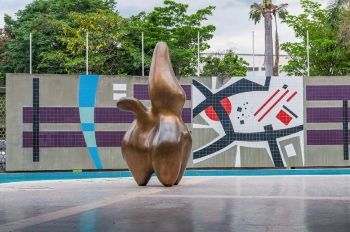
Biomorphic sculpture emphasized the practice of Direct Carving and using the material's grain, texture, and density to energetically shape the artwork. As a result, wood, marble, and local stones were often preferred materials. Since Direct Carving involved intense engagement; many of the final pieces expressed an intimate involvement that connected the work to the artist and viewer's subconscious. Sometimes created on a small scale, the organic forms, resembling shells, stones, or small living creatures, could be held and rearranged by the viewer with the result that they evoked ever more associations, as seen in Arp's pioneering works like Sculpture to be Lost in the Forest (1932).
Barbara Hepworth and Henry Moore's biomorphic forms emphasized a correspondence between the human body and the natural landscape. Hepworth pioneered "piercing" the form with an empty space so that the holes would lend themselves to both abstracting the human form while also suggesting eroded landforms. Many of the Biomorphic artists developed a signature visual vocabulary, as seen in Miró's preoccupation with birds, the sun, the moon, and personages (unidentifiable but humanoid figures), or Isamu Noguchi's interlocking sculptures like Kuoros (1945). By the 1950's Arp, Miró, Karl Hartung, and Moore were creating a great many public sculptures, cast in bronze, as seen in Arp's Cloud Shepherd (1953), or in concrete, as seen in Miró's Dona i ocell (Woman and Bird) (1982).
Furniture design
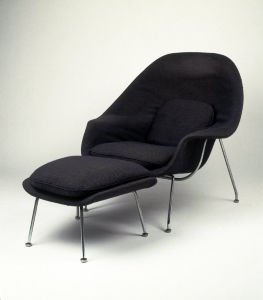
A number of furniture designers, including the American couple Charles and Ray Eames, the Finnish-American industrial designer and architect Eero Saarinen, and the artist Isamu Noguchi employed biomorphic designs. Charles and Ray Eames and Saarinen collaborated in 1940 on furniture designs that were awarded first prize in the Museum of Modern Art's Organic Design in Home Furnishings competition. In 1946 the museum held Charles Eames' exhibition, making him the first designer to have a solo MoMA show. New technologies, including laminates and the ability to shape and bend materials, made it possible for designers to explore ever more organic designs, and the rounded shapes appealed to the public both in terms of comfort and modern aesthetic appeal. Saarinen's noted designs included his Womb Chair, Model No. 70 (1947-48) and Tulip Chair (1956), which was made of aluminum, molded fiberglass, and a plastic bonded finish.
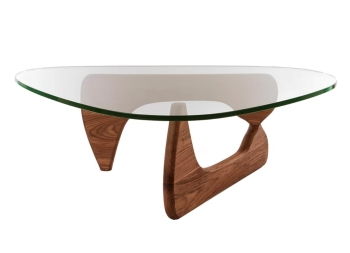
Isamu Noguchi felt that all of his works, whether furniture, lamps, gardens, or public works of art, could be considered sculpture. His iconic and classic coffee table, designed in 1946, used a glass top over two interlocking pieces of wood of biomorphic shape. In Denmark the architect Arne Jacobsen became best known for his chairs the Ant (1951), Egg (1957), and Swan (1957), which have become ubiquitous modern styles. The Eames Lounge Chair and Ottoman, as well as Noguchi's table, are still being produced today.
Later Developments - After Biomorphism
Biomorphism became an early influence on the leading Abstract Expressionists, including Jackson Pollock, Mark Rothko, William Baziotes, and Robert Motherwell, most of whom acknowledged Miró as an influence. Arshile Gorky was also influenced by Miró, and his own work influenced Willem de Kooning. Yves Tanguy's work influenced Dalí, and later Isamu Noguchi, Roberto Matta, Wolfgang Paalen, and Esteban Francés.
Legacy
The 1950s became dominated by Abstract Expressionism. Art historian Deborah Wye wrote: "the profound shift into abstraction that overtook many American artists between 1947 and 1950 constituted a break that put an end to the exploration of the biomorphic and organic: Arshile Gorky died, de Kooning literally tore the biomorphic to shreds in his 1948-49 black paintings, and William Baziotes commenced treading water."
Nonetheless, Miró and Arp continued to work biomorphically, their fame attracting commissions for monumental public works. In England, Moore and Hepworth continued to define modern British sculpture and influenced Eduardo Paolozzi, Anthony Caro, and Phillip King. Later, contemporary artists such as Tracey Emin, Charlotte Moth, and Rachel Whiteread were inspired by both Hepworth's work and her position as a role model for female artists.
Biomorphism influenced later artists, like Anish Kapoor whose biomorphic sculptures, as he said, "form themselves out of each other," as if growing out of walls or floors. Lynda Benglis poured brightly colored polyurethane foam over wire armatures to create what art critic Hilarie M. Sheets described as "evocative of lava flows, monstrous crustaceans." Eva Hesse's biomorphic work like Untitled (Rope Piece) (1970) was described by art critic Grace Glueck as "like the work of giant spiders gone berserk.. Its strident arrhythmia seems to mock comfortable notions of composition and aesthetic purpose." Biomorphism also influenced the designers Ron Arad, Paul Rand, Lucienne Day, and Julian Hatton. Louise Bourgeois, who remained relatively unknown until the 1970s, continued to create powerful, darkly psychological, biomorphic sculptures into the 21st century.
Useful Resources on Biomorphism
-
![Joan Miró - Short biography]() 0 viewsJoan Miró - Short biography
0 viewsJoan Miró - Short biography -
![The Surreal Worlds of Kay Sage and Yves Tanguy]() 0 viewsThe Surreal Worlds of Kay Sage and Yves TanguyArtsWestchester
0 viewsThe Surreal Worlds of Kay Sage and Yves TanguyArtsWestchester - Arp: The Poetry of FormsKröller-Müller Museum
- Joan Miró: The Ladder of Escape
-
![Desmond Morris on Joan Miro | TateShots]() 12k viewsDesmond Morris on Joan Miro | TateShots
12k viewsDesmond Morris on Joan Miro | TateShots -
![Meet the Author: Listening to Stone: The Art and Life of Isamu Noguchi by Hayden Herrera]() 6k viewsMeet the Author: Listening to Stone: The Art and Life of Isamu Noguchi by Hayden HerreraJapan Society NYC
6k viewsMeet the Author: Listening to Stone: The Art and Life of Isamu Noguchi by Hayden HerreraJapan Society NYC -
![Isamu Noguchi, Archaic/Modern Curator Talk with Dakin Hart]() 9k viewsIsamu Noguchi, Archaic/Modern Curator Talk with Dakin HartSmithsonian American Art Museum
9k viewsIsamu Noguchi, Archaic/Modern Curator Talk with Dakin HartSmithsonian American Art Museum -
![Isamu Noguchi on Time and Furniture]() 0 viewsIsamu Noguchi on Time and Furniture
0 viewsIsamu Noguchi on Time and Furniture -
![Arshile Gorky. Abstract Expressionist. The Art of America documentary Clip]() 2k viewsArshile Gorky. Abstract Expressionist. The Art of America documentary Clip
2k viewsArshile Gorky. Abstract Expressionist. The Art of America documentary Clip - Meet Louise BourgeoisTate
 Ask The Art Story AI
Ask The Art Story AI